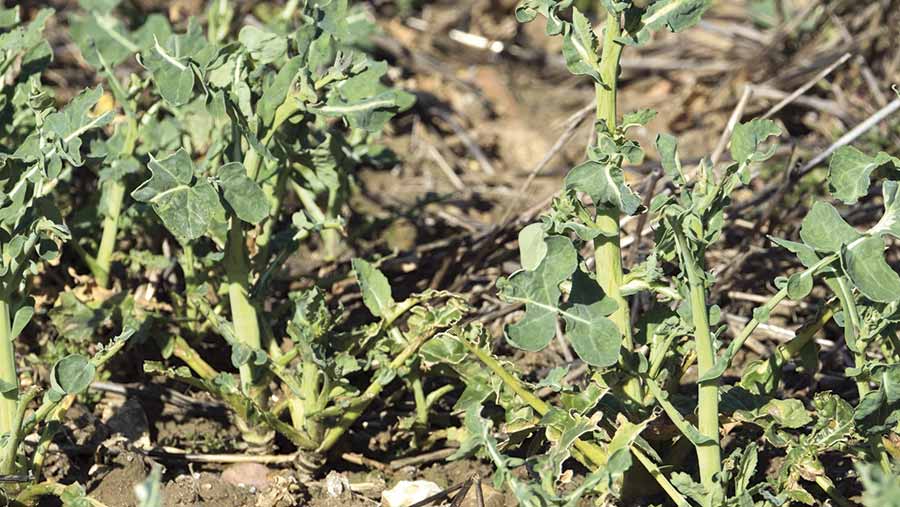Crop watch: Spring work on hold after rapid thaw
 © Tim Scrivener
© Tim Scrivener Up to 10 days of drier weather will be needed before spring work can start in earnest as the rapid thaw last week has left fields surprisingly wet.
Meanwhile our crop watch agronomists report major pigeon damage in oilseed rape crops but recommend waiting until crops start recovering before spraying for light leaf spot.
They report early signs of lesions since the snow has cleared, and there has also been a noticeable increase in septoria in wheat in the West.

East: Marion Self
Prime Agriculture (Suffolk)
It’s turning into a late spring with wet fields and stressed crops, not to mention frustrated growers and muddy agronomists!
Field walking has revealed that in the main, autumn residuals have worked well in easier-to-moderate blackgrass situations, although at more difficult sites, large, well-tillered grassweeds appear unaffected.
Heavy stacks of autumn residuals have cleaned up most broad-leaved weeds. Groundsel, fool’s parlsey and other tricky-to-identify umbelliferae appear to be the most frequent survivors.
See also: Gloucester winter barley gets first nitrogen to overcome yellowing
The cold weather has also lowered the rust and mildew risk and slowed the development of septoria. This season, most wheat varieties will not require fungicide treatment until T0 later this month.
As wheels begin to turn, the priority is to apply the first dose of fertiliser (nitrogen and sulphur) and treat manganese deficiency, especially where symptoms are severe after the snow. When crops are less stressed and actively growing, grassweed treatments can be applied with less risk of crop damage.
Wait for growth
On fields destined for spring cropping, take the opportunity to spray off the green bridge ahead of cultivations.
In many situations, this will be the most effective grassweed control available, followed by appropriate pre-emergence herbicides.
Although it is frustrating seeing the spring workload concertina, try to be patient with seed-beds and wait for good conditions before sowing.
It is also worth noting that during the Ecological Focus Area fallow period (1 January 2018 to 30 June 2018), you must not apply any plant protection products, including glyphosate.
Weather-beaten and pigeon-ravaged rapeseed crops look and smell horrible. Fortunately, most crops have good root systems and will recover quickly when conditions allow more growth.
Wait until crops are recovering before choosing and applying appropriate plant growth regulation and light leaf spot applications at green bud.

West: Antony Wade
Hillhampton Technical Services (Herefordshire/Shropshire)
The arctic blast has certainly put things on hold, making the dash around looking at oilseed rape crops the week before a bit futile.
Whilst the cold temperatures have slowed growth, with well-set crops in my region, I believe the temperatures were not a significant problem. The bigger challenge has been the associated wetting of the soil the snow has caused.
On the plus side, the cold weather means that the usual three-day window after 1 March but before buds visible on oilseed rape for applications of Galera (clopyralid + picloram) and Dow Shield (clopyralid) is slightly wider this season.
However, we need soils to dry significantly in the next 10 days to be able to get these products applied where needed.
Light leaf spot
Light leaf spot before the cold weather was difficult to find. However, some visits since the snow has cleared are revealing some developing lesions.
Some of these look suspiciously like white leaf spot, which I haven’t seen for a number of years and are still to be confirmed.
First fertiliser dressings on winter barley, where they have not been applied, will also be a priority once we can travel, as some crops are particularly banana-like in colour.
These crops will need to be assessed in the next week for whether a T0 split of plant growth regulator with or without a low rate of fungicide is needed to quell early disease levels.
I have used this strategy in the last few seasons, as I believe it helps ensure tiller retention and grain set.
Wheat crops generally are faring pretty well, with tiller numbers above average on September-drilled crops and close to average for October drillings. There has been a noticeable increase in septoria on lower leaves in the past four to six weeks.
Residual herbicide strategies have worked well and there is very little sign of a spring germination of broad-leaved weeds – another benefit of the cold weather.

North: Mary Munro
AICC/Strutt and Parker (Perthshire)
Four weeks ago, we were beginning to get excited about possible fertiliser application, then along came the winter.
The Borders had it worst with probably 18in of snowfall and strong winds creating massive drifts, while Fife and Perthshire had more manageable quantities.
The amount of water left as it melted has varied tremendously. Some fields are totally sodden but others are surprisingly dry in comparison, and at this time of year, things can dry out incredibly quickly.
There is now a long list of things that would normally already have been done and need to be prioritised for when the ground conditions allow traffic.
For those who did not make use of the harder ground before the snow, first dressings of nitrogen and sulphur fertiliser are top of the list. Winter barleys emerged from the snow looking hungry and yellow, and oilseed rape similar.
Pigeon damage
The bottom rapeseed leaves died off and the pigeons have hammered the tops, but close inspection shows that the buds are formed, and these crops will take off quickly once there is some warmth.
Plant populations are good. Disease levels on the newest leaves are low. The spring light leaf spot spray is best aimed for early stem extension when the crop is around welly-boot height. I am looking at tebuconazole still as the favoured option.
There is so little active disease now in winter barley I think we will be able to wait until T1 and deal with everything then. I rather suspect the gap between a T0 and a T1 might be minimal this season.
Wheat is more likely to receive a T0 on more advanced crops in the Lothians. The plan for the late-sown wheats north of the Forth will be to skip T0, but the fine tuning of who gets what depends on variety and local disease pressure.
Where it goes on, T0 will probably be Cherokee – a tried and trusted cost-effective option at this timing.

South: Richard Harding
Procam (Sussex)
The snow has all but disappeared across the Downs, apart from a few stubborn patches under sheltered hedge bottoms. A reasonably dry week has allowed some of the wetter fields to drain and they are now starting to dry out slowly.
Some oilseed rape and winter cereals have started to receive their first dose of nitrogen. All crops, but especially winter barley, have started to look stressed and short of nutrition.
Wet areas in wheat fields are also starting to show stress more severely.
Soil temperatures for the most part are still below 5-6C. Meanwhile, the extended daylight hours and higher light intensity are starting to get the crops “ticking over”, and a small rise in soil temperatures will see crops moving quickly.
Subsequently, cereal T0 fungicides, plant growth regulators and if required, foliar nutrition are being organised, or will be shortly.
Adjust seed rates
This year for winter wheat; depending on variety, disease levels and an anti-resistance strategy, programmes will be based on tebuconazole, prochloraz, and chlorothalonil, plus fenpropidin where mildew is present.
Unusually, very little spring barley has been drilled, even on lighter fields. As ever, though it is important that spring crops go in well, adjusting spring cereal seed rates to ensure competitive crops are established is essential.
Moist seedbeds offer the opportunity for a pre-emergence herbicide of pendimethalin, chlortoluron and diflufenican to work effectively.
Oilseed rape crops, although generally well grown, are under constant pressure now from pigeons.
Now that the snow and frosts have diminished, the focus has been on checking for light leaf spot.
Incubation of leaves in a closed and humid plastic bag, kept somewhere warm, is necessary to get a true interpretation of the levels of disease present.
Strange as it may seem under current conditions, sclerotinia monitoring for sclerotia “germination” begins in early March.
Tip of the week
Wait until oilseed rape crops are recovering from weather and pigeon damage before choosing and applying appropriate plant growth regulation and light leaf spot applications at green bud Marion Self

